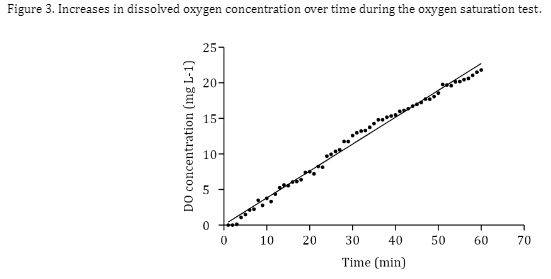Ultrafine bubble generator for oxygenation of Nile tilapia (Oreochromis niloticus) breeding tanks under recirculating water system
DOI :
https://doi.org/10.21708/avb.2023.17.2.11242Résumé
The objective of this work was to evaluate the use of an ultrafine bubble generator of own manufacture for oxygenation of Nile tilapia (Oreochromis niloticus) breeding tanks in a recirculating water system. The research was divided into two steps: 1) oxygen saturation test; 2) application of ultrafine bubble production technology for the breeding of Nile tilapia. In the first step, the water of a 2.0 m3 test tank was completely deoxygenated and the ultrafine bubble generator was turned on for 60 min. In the second step, the generator was connected to the water recirculating system for breeding of Nile tilapia to compare the overall performance of this system with other under conventional aeration system. The ultrafine bubble generator could reach 100% oxygen saturation in the test tank (27.8 °C) in approximately 21 min and, at the end of 60 min, the concentration was 21.8 mg L-1 (277.52% saturation). The results showed significant difference (p<0.05) between the mean dissolved oxygen concentration in the treatment with ultrafine bubbles (9.80 ± 3.68 mg L-1) and the treatment with conventional aeration (3.47 ± 0.88 mg L-1). No significant difference (p>0.05) was found for the zootechnical performance parameters evaluated. The conclusion was that the ultrafine bubble generator is more efficient to maintain a high dissolved oxygen concentration in the recirculating water in Nile tilapia breeding tanks than the conventional aeration system.
Téléchargements

Téléchargements
Publié-e
Numéro
Rubrique
Licence
(c) Tous droits réservés Acta Veterinaria Brasilica 2023

Cette œuvre est sous licence Creative Commons Attribution 4.0 International.
Autores que publicam na Acta Veterinaria Brasilica concordam com os seguintes termos: a) Autores mantém os direitos autorais e concedem à revista o direito de primeira publicação, com o trabalho simultaneamente licenciado sob a Licença Creative Commons Attribution que permite o compartilhamento do trabalho com reconhecimento da autoria e publicação inicial nesta revista. b) Autores têm autorização para assumir contratos adicionais separadamente, para distribuição não-exclusiva da versão do trabalho publicada nesta revista (ex.: publicar em repositório institucional ou como capítulo de livro), com reconhecimento de autoria e publicação inicial nesta revista. c) Autores têm permissão e são estimulados a publicar e distribuir seu trabalho online (ex.: em repositórios institucionais ou na sua página pessoal) a qualquer ponto antes ou durante o processo editorial, já que isso pode gerar alterações produtivas, bem como aumentar o impacto e a citação do trabalho publicado (Veja O Efeito do Acesso Livre).


 Esta obra está licenciada com uma Licença
Esta obra está licenciada com uma Licença 